Mapping the Geology of South America
Jorge Gómez Tapias, Carlos Schobbenhaus, Nohora Emma Montes Ramírez, Fernando Alirio Alcárcel Gutiérrez, and Daniela Mateus Zabala
Abstract
The Geological Map of South America (GMSA) at a scale of 1:5,000,000 illustrates recent progress in South America’s geological mapping. Information compiled from the national geological maps of different countries and regional maps was generalized and harmonized at the 1:5,000,000 scale and then enhanced with geochronological information from indexed journals. The digitization, harmonization, and editing of the map were performed with the shaded relief image with a 90 m resolution in the background, facilitating excellent georeferencing and allowing for future updates to the map according to continued research. To construct the GMSA, eight workshops were held to discuss and define its characteristics. The most relevant workshop was held in Villa de Leyva, Colombia, with the participation of delegates from several countries. Here, we obtained the official geological cartography of each South American country and made agreements for the realization or revision and endorsement of the final map. The remaining workshops involved the groups overseeing the GMSA at the Colombian Geological Survey and the Geological Survey of Brazil, who compiled and integrated the map. Specifically, the GMSA includes layers of chronostratigraphic units, faults, folds, basaltic dikes, intrusive and alkaline volcanic rocks–carbonatites, high–pressure metamorphic rocks, impact craters, kimberlites, and volcanoes.
Introduction
The third edition of the Geological Map of South America (GMSA), at a scale of 1:5,000,000, was produced by the South American Subcommission of the Commission for the Geological Map of the World (CGMW) and the Association of Iberoamerican Geological and Mining Surveys and the cooperation of the geological surveys from Colombia, Brazil, Argentina, Chile, Peru, Uruguay, and Ecuador and aid from several universities and research institutes.
In 2008, the project was approved during the General Assembly of the CGMW at the 33rd International Geological Congress in Oslo, Norway. It was first advanced in three workshops held in Tabatinga, Brazil involving the geological surveys of Colombia, Brazil, and Peru on October 1 to 2, 2009, August 8 to 13, 2010 (Figure 1a), and November 29 to December 1, 2011. In these workshops, a diagnosis of the geology of these three countries was completed —there was no coincidence between their geological maps—, a draft of the legend was prepared, and the parties agreed that the Colombian Geological Survey (CGS) would be responsible for integrating and harmonizing the geology of the Andes and Patagonia and the Geological Survey of Brazil (CPRM) for these tasks concerning the South American platform.
The project received an important impetus from the Geological Map of South America Workshop held from July 21 to 26, 2014 in Villa de Leyva, Colombia, which was organized by the CGS and attended by 43 delegates from Argentina, Bolivia, Brazil, Chile, Colombia, Ecuador, France, Holland, Peru, Spain, Suriname, Uruguay, and Venezuela (Figure 1b). In this workshop, the official geological mapping of each South American country was provided. In addition, one delegate from each country presented its national map.
The four most important results of the workshop were as follows: first, two coordinators were appointed per country. Second, Argentina, Venezuela, and Ecuador would create the generalization at a scale of 1:5,000,000 and then send it to the compiler group in the CGS. Moreover, the CGS would generalize Chile, Peru, Uruguay, and Bolivia at a scale of 1:5,000,000 and then send these maps to their corresponding geological survey or university to be reviewed, discussed, and endorsed. The South American platform would be compiled, harmonized, and generalized by the CPRM, as previously discussed. Third, a joint proposal for a legend would be made that represented the singularities in the geology of each region. Fourth, all general knowledge on the geology of South America was compiled.
Following the Villa de Leyva workshop, the CGS and CPRM appointed a group of researchers dedicated exclusively to producing the GMSA. Subsequently, from May 16 to 20, 2016, a fifth workshop was held in Rio de Janeiro, Brazil, between the CPRM and CGS (Figure 1c). In this workshop, the progress of the map was presented, and the codes for the chronostratigraphic units were defined.
The style model comprising the folds, faults, chronostratigraphic units, Quaternary volcanoes, impact craters, high–pressure rocks, suture zones, basic dikes, plutonic and volcanic alkaline complexes, plate boundaries, oceanic structures, glaciers, salt lakes, oceanic crusts, and bathymetry was agreed upon, and the GMSA’s four insets —the regional map of plate tectonics, the legend, the symbology, and the format— were defined. To ensure that all the geological events in the Andes were represented on the GMSA and the ability to correlate the chronostratigraphic units with the same ages that represent a single event, the Geological Evolution of the Andes Workshop was held from December 5 to 10, 2016, led by Professor Victor A. Ramos of the University of Buenos Aires, Argentina (Figure 1d). During this workshop, the number of chronostratigraphic units in the Andes was reduced by half, which made the map much more legible. Additionally, it was assured that each tectonic event would be represented in at least one polygon on the map. For example, the Ojo de Colorado Basic Complex and Loma Alta Gabro were included —units that represent land suture zones accreted to the Gondwana proto–margin during the Paleozoic.
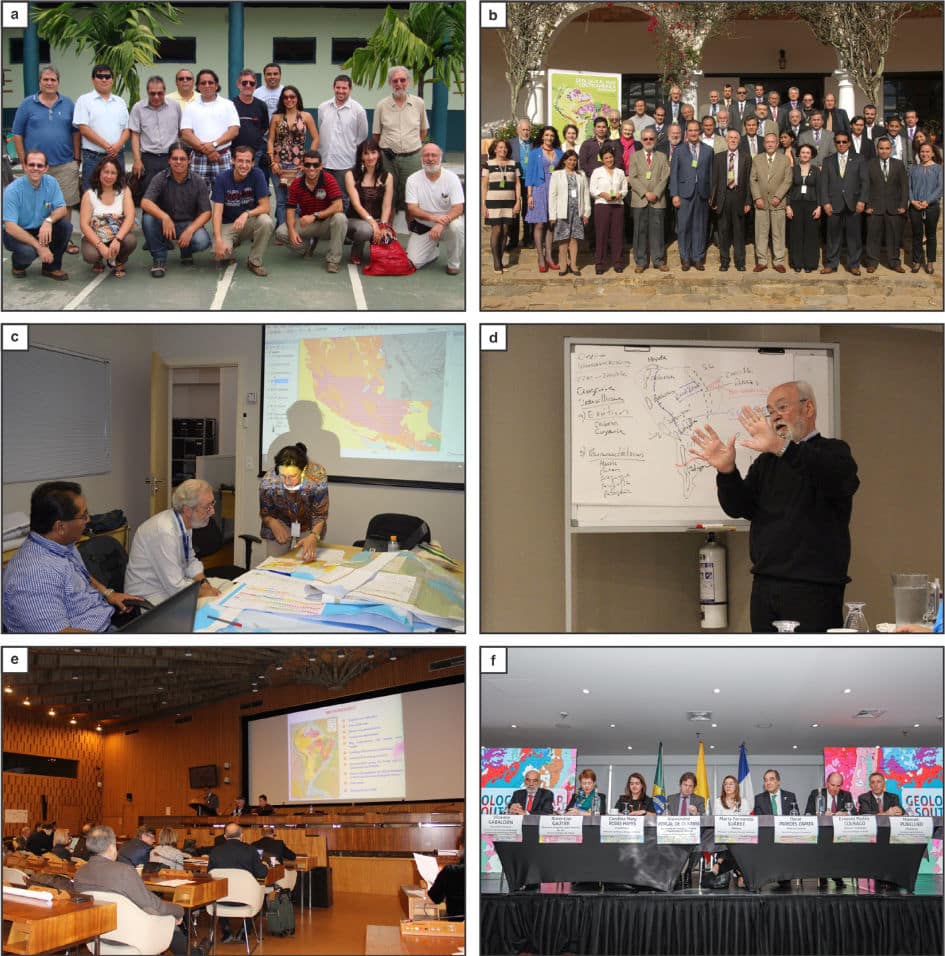
During the second semester of 2007, the harmonization of the Andes and Patagonia was completed. This work did not have any major complications because most of the units concerned the Neogene and Quaternary.
The first version of the GMSA was presented during the General Assembly of the CGMW from February 20 to 23, 2018 at the UNESCO offices in Paris, France. In this conference, there was space for discussion concerning the map (Figure 1e). Finally, the eighth workshop was held on June 28, 2018, in Villa de Leyva, Colombia, to address the comments of map reviewers and to define and agree on the GMSA’s final insets.
The GMSA was thus a project executed over 11 years. The map’s international launch occurred on November 26, 2019, in Bogotá, Colombia, amid the presence of the directors of the geological surveys of Colombia and Brazil, delegates from France’s Bureau de Recherches Géologiques et Minières of France, and the president of the CGMW (Figure 1f).
The GMSA, therefore, represents the vast magnitude of the recent progress in the geology of South America. Specifically, it incorporates novel cartography, which in several countries has been performed on a larger scale, data from hundreds of scientific publications, new geochronological ages, and advances in geographic information systems that allow, e.g., the use of shaded relief images to enable harmonizing and georeferencing geological information (Figure 2).
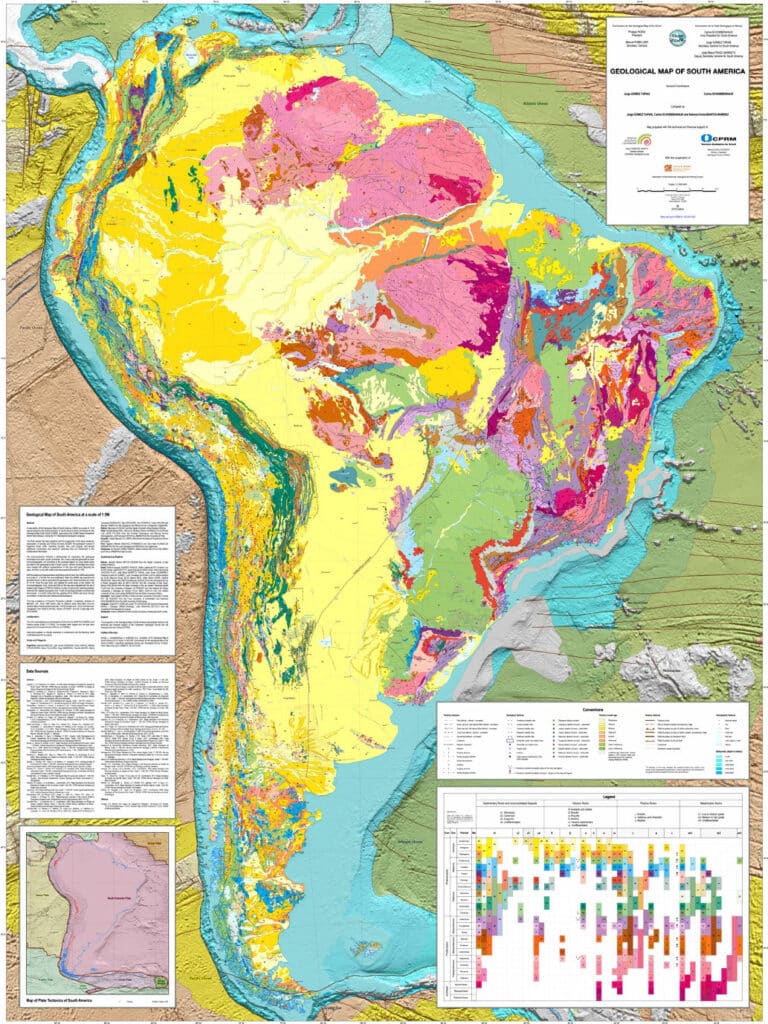
Data Sources
For the generalization and harmonization of the GMSA at 1:5,000,000, analog and digital maps with scales ranging from 1:500,000 to 1:1,000,000 were used. For Brazil, in addition to a national geological map, geological maps of different states and some geological sheets were used (Figure 3).
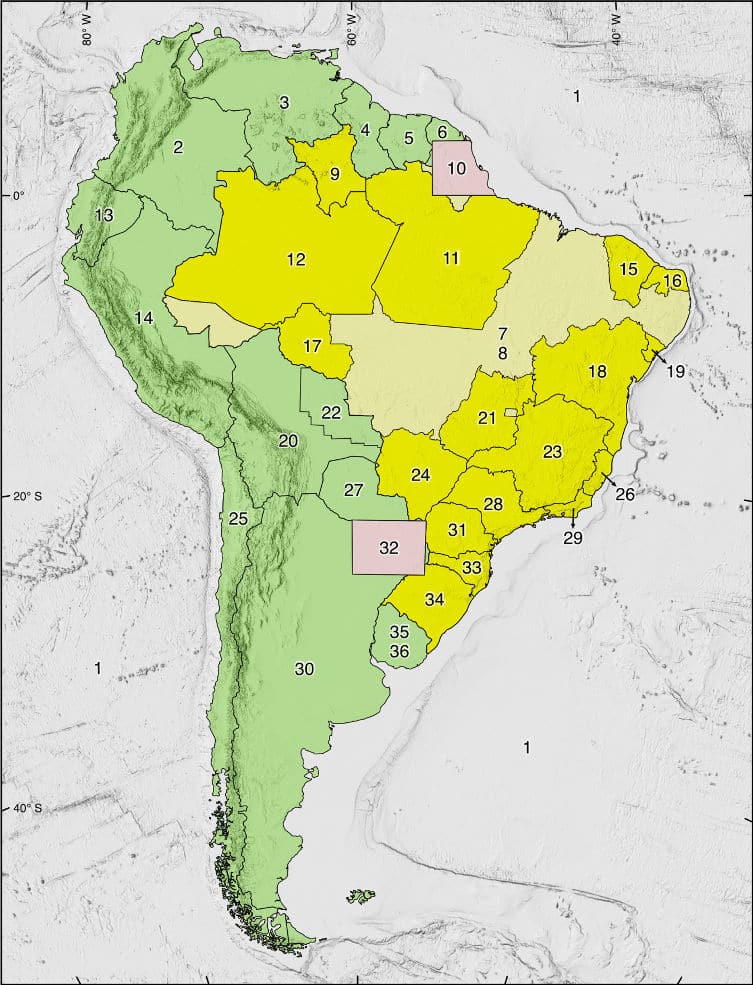
Methodology
The GMSA’s chronostratigraphic units (CUs) were classified according to the age and type of rock or deposit. Every age was differentiated based on System/Period, and all rocks were differentiated as sedimentary, igneous, or metamorphic rocks. Sedimentary rocks were grouped as siliciclastic, carbonatic, evaporitic, or undifferentiated; volcanic rocks as andesitic and related, basaltic, rhyolitic, alkaline, volcano–sedimentary, or undifferentiated; plutonic rocks as granitic, gabbroic and ultramafic, or alkaline; and, finally, metamorphic rocks as low to medium grade, medium to high grade, or undifferentiated.
Point entities including alkaline intrusions/carbonatites, kimberlites and related rocks, impact craters, volcanoes, and high–pressure metamorphic rocks (eclogites and blueschists) are represented on the map; regarding linear entities, dikes and kimberlite clusters and related rocks are represented as polygons.
Each CU symbol has a color that indicates age and a pattern that indicates rock type. The only rocks that did not receive such screening were siliciclastic rocks. For the color of each CU, the values of red, green, and blue established in the International Chronostratigraphic Chart v2018/08 (Cohen et al., 2013) by the CGMW were used. However, the colors for the Precambrian units were chosen via a proposal presented by the CPRM because the diversity of units at this age and the small sizes of several of these units’ polygons necessitated greater differentiation than that allowed by the colors established in the International Chronostratigraphic Chart for this geological time range. For the colors of the patterns, the criterion was that they had must effectively contrast with the background. These were created in CorelDraw 12 and then exported to a font file (True Type font), which, once loaded in ArcGIS, allowed us to generate the style that contains each symbol used on the map for each unit. The methodology of creating the patterns with a source file was adapted from the Geological Map of North America (Reed et al., 2005), which had been used successfully to generate the Geological Map of Colombia 2015 (Gómez et al., 2015). This offers great advantages such as generating a rapid display of a map in ArcGIS, a clear graphical output (Figure 4), a smaller file size (PDF), as well as reducing printing time.
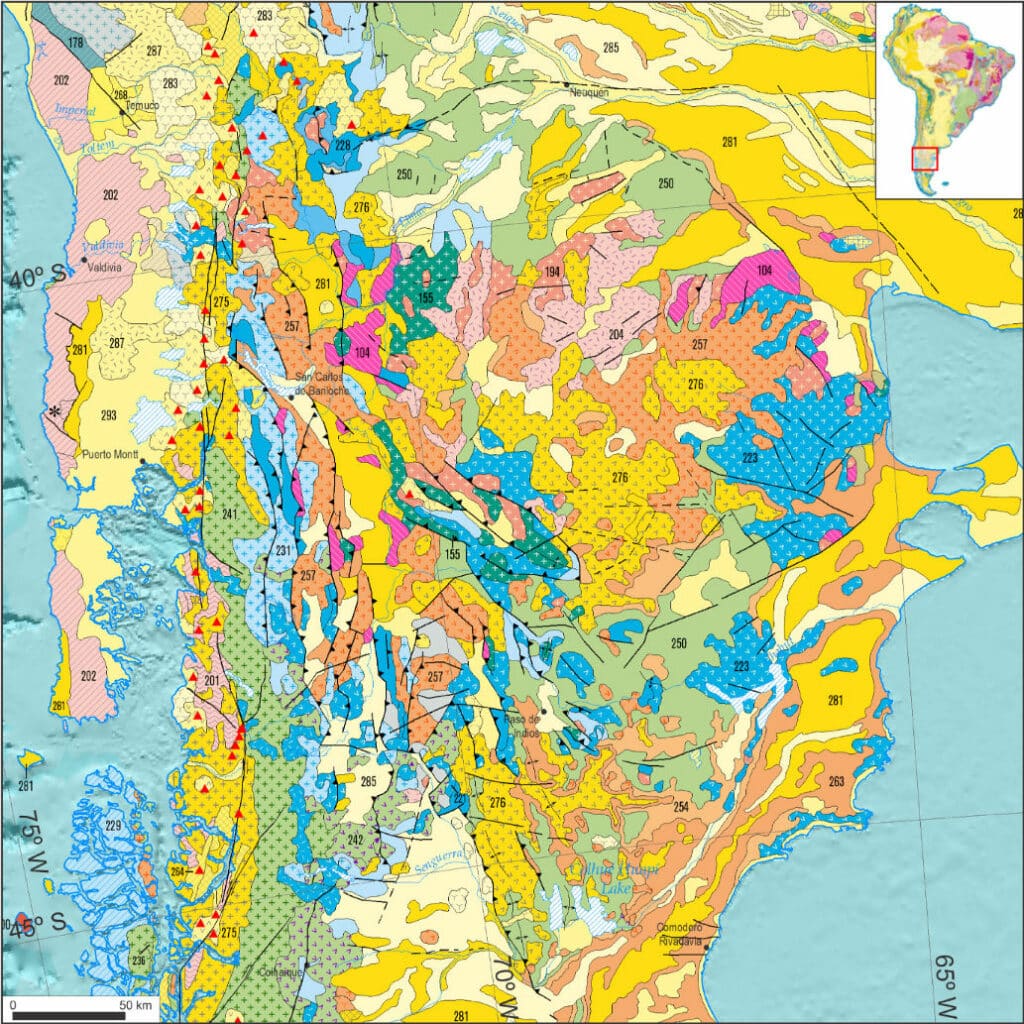
For the definition and generalization of the CUs, the methodology entailed listing the original lithostratigraphic units from the geological map of each country with their respective age and description. Then, a new code was built for each unit according to the age and rock type criteria defined for the GMSA.
For this, the coverage of the polygons with geology was displayed in ArcGIS, and then a new field was added with each code at a 1:5,000,000 scale. From these new codes, a symbology was created with colors that represent the ages and patterns of each type of rock, and then a map was generated with the units coded at 5M. The map with this novel 5M symbology and coordinate grid was subsequently printed at the 1:3,000,000 scale to group and generalize the units via a freehand method. This analog map was then scanned and georeferenced to digitize the new CUs, faults and folds at 5M.
This analog map was then scanned and georeferenced to digitize the new CUs, faults and folds at 5M. As the majority of geological maps were first published many years ago, when necessary, we updated the ages of the CUs with recent scientific publications concerning each focal country’s geological information (mainly radiometric dating). For example, for the Geological Map of Peru (Ingemmet, 2016), the Paleozoic CUs were updated with the relevant ages in Chew et al. (2007, 2008) and Mišković et al. (2009).
For generalization, the latest editions of published maps were used, such as the Geological Map of Ecuador (Egüez et al., 2017), the Geological Map of Peru (Ingemmet, 2016), and the Geological Map of Colombia (Gómez et al., 2015). The CGS performed the generalization and harmonization of the geology of Peru, Chile, Bolivia, and Uruguay. Although Ecuador had already created a map at the 1:5,000,000 scale, it was necessary to revise it with the relevant criteria, since a later version had been published that was better georeferenced than the previous version.
The generalization of the 5M geological map of the South American platform was performed by the CPRM. All generated maps were sent in paper so that their georeferencing and digitization could be completed by the CGS.
Shaded relief images of South America were used as the main harmonization tool for the GMSA. These were performed in ArcGIS 10.2 via the Shuttle Radar Topography Mission’s grid with a resolution of 90 m, downloaded from the website of the United States Geological Survey (USGS, 2002).
Each image was created with a simulation of solar illumination with azimuths of 315° and 45° and a height of 45° to simulate the sun at approximately 10 a.m. in Bogotá, Colombia. Each shaded relief image of 45° was displayed with 50% transparency superimposed on that of 315° of azimuth. Because the Andes Cordillera crosses the continent from south to north, this type of display prevents very dark parts in an image, allowing the enhancement of terrain characteristics to facilitate observation of the main geological structures (Figure 5).
The GMSA base map was prepared with shaded relief images, Landsat TM and Google Earth images, generalized at a 1:5,000,000 scale. For harmonization, the CUs were superimposed with 50% transparency on the shaded relief image of South America and extended from one country to another. Similarly, this was performed for the layers of faults and folds. Although the GMSA has a scale of 1:5,000,000, its chronostratigraphic units were perfectly adjusted to relief features via these shaded relief images, allowing both the implementation of its web services and its display on Google Earth. Correctly adjusting the CUs took more than three years, since in many areas, such as Bolivia, all the information had to be re–digitized.
The 419 volcanoes of the Quaternary were plotted using the geological maps of each country when available or were obtained from Volcanoes of the World (Siebert et al., 2010) or the database of the Global Volcanism Program at the Smithsonian Institution (https://volcano.si.edu). Likewise, the impact crater layer in South America was taken from Impact Cratering: The South American Record–Part 1 and Part 2 by Crósta et al. (2019a, b). Additionally, perfect georeferencing of these two layers was performed with the addition of Google Earth images.
For the marine areas, the coverage of the oceanic crust on the Tectonic Map of South America was used (Cordani et al., 2016). For these areas, each shaded relief image was created in the same way as for the continental areas using the grid of Gebco (2014).
For the area of western Colombia, the ages of the oceanic crust and its structures were updated following Morell (2015) and Lonsdale (2005). Finally, once the maps of the Andes and Patagonia were integrated by the CGS and the South American platform had been produced by the CPRM, a first draft was generated and then sent to the delegates of each country for review, discussion, and approval.
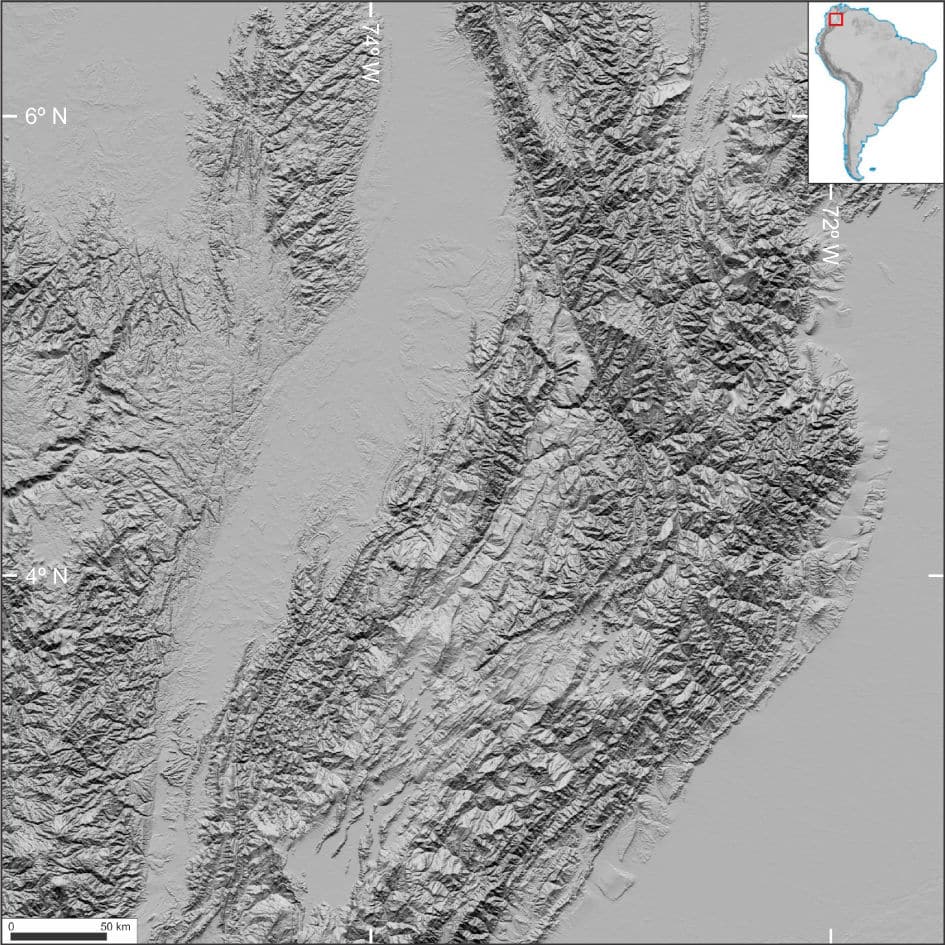
Editing
For the GMSA, editing was performed to ensure perfect visualization. This editing work lasted a year and a half and consisted of the continuous printing of periodic versions of the map until a good visualization of the CUs and optimal density of information was achieved. In this way, the minimum polygon size was defined as 10 km2; the color and thickness of faults and folds were adjusted; the fonts, sizes of annotations and their locations on the map were selected; and the symbologies for the dikes, kimberlites, impact craters, volcanoes, and high–pressure metamorphic rocks were created. Subsequently, a review ensured that in each 10 cm2 box, there would be at least one annotation for a given CU (Figure 6a). For the dikes and carbonatites, colors were assigned to represent their ages that contrasted well with the colors of the CUs.
The order of the CUs changed several times due to revisions based on the innumerable reviews of the geology by the CPRM, and junior researchers of the CGS who verified each CU to ensure that there were no errors (Figure 6b). Once the GMSA passed the peer review that the CGMW requires of all its publications, a thematic style correction was made.
The GMSA includes six relevant insets as follows: format, conventions, legend, sources of information, abstract, and a map of South America’s tectonic plates (Figure 2). As part of the map legend, the International Stratigraphic Chart v2018/08 (Cohen et al., 2013) is reproduced on the GMSA’s left side with each rock type listed at the top. Each CU was assigned an integer, sorted in ascending order by age. Hence, the most recent materials are at the top of the legend (Figure 7). This same number was used to label the different units on the map for a total of 292 units.
Likewise, to represent alkaline intrusive/volcanic and mafic dikes, symbols with different colors were used and a number was assigned to represent them—from 293 to 302 for alkaline intrusive/volcanic dikes and from 303 to 307 for dikes (Figure 7).
For the reader to achieve a good understanding of the map, the legend of the GMSA should be printed.
To grasp which CU corresponds to a certain number, one must consult the legend. First, the pattern in the upper part of the legend that represents the lithology must be identified; then, one must scan downward until the number is identified and then horizontally to the left until its age is found. Thus, for example, the number 127 corresponds to gabbroic and ultramafic rocks from the Ediacaran (635–541.0 Ma) and the number 18 to Neoarchean volcano–sedimentary rocks (2800–2500 Ma).
The inset Map of Plate Tectonics of South America shows the locations and boundaries of the plates associated with the continent and its tectonic framework: South American, Nazca, Cocos, Caribbean, Antartic, Scotia, Sandwich, and African. In addition, the distribution of Quaternary volcanoes is shown, while the Andean deformation belt is differentiated from the South American platform. Another inset indicates all the geological maps that were used in the compilation of the GMSA, illustrated in Figure 3.

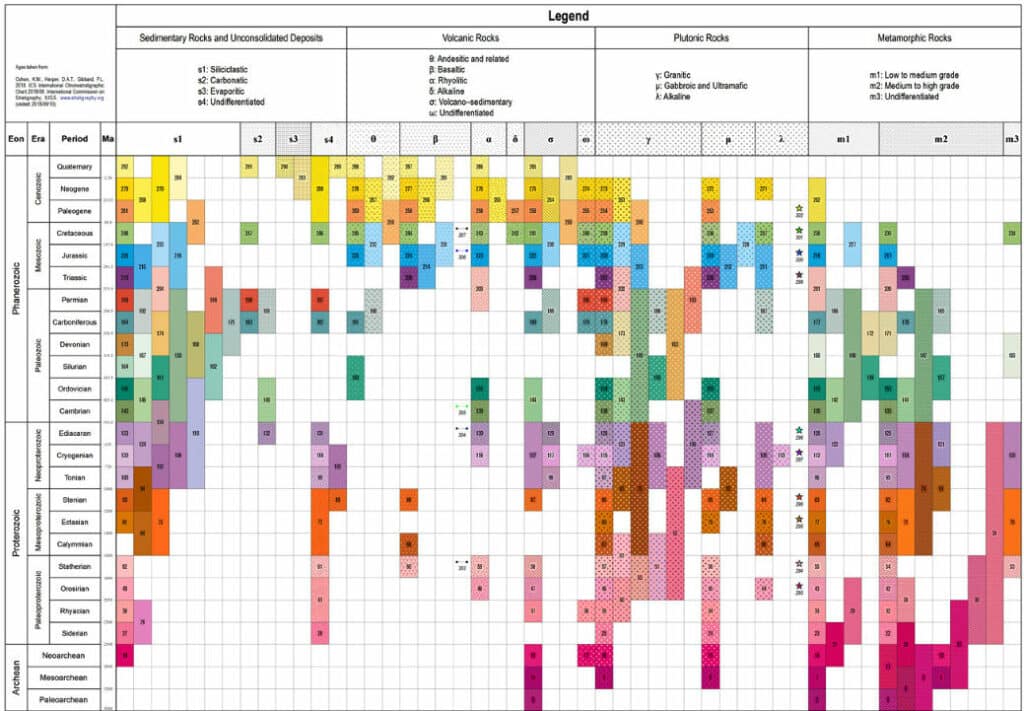
Geographical Information Systems (GIS)
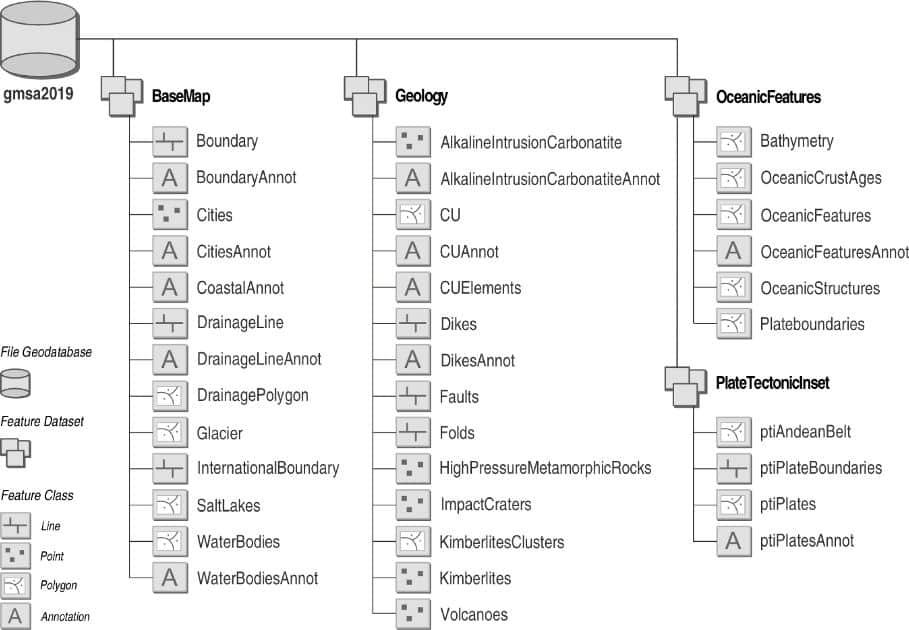
The GIS of the GMSA was structured in ArcGIS 10.2.2 software. For this, a File Geodatabase was created with the following datasets: Base Map, Sources, Geology, Oceanic Structures, and Tectonic Plates. Each of these datasets is made up of related entities or feature classes; for example, Geology comprises the feature classes of chronostratigraphic units, faults, folds, basic dikes, volcanic and intrusive alkaline‒carbonatites, blueschists and eclogites, kimberlite fields, impact craters, Quaternary volcanoes, and their annotations, which identify these entities on the map. The structure of the GIS of the GMSA is illustrated in Figure 8. 18 to Neoarchean volcano–sedimentary rocks (2800–2500 Ma). The inset Map of Plate Tectonics of South America shows the locations and boundaries of the plates associated with the continent and its tectonic framework: South American, Nazca, Cocos, Caribbean, Antartic, Scotia, Sandwich, and African. In addition, the distribution of Quaternary volcanoes is shown, while the Andean deformation belt is differentiated from the South American platform. Another inset indicates all the geological maps that were used in the compilation of the GMSA, illustrated in Figure 3. Geographical Information Systems (GIS) The GIS of the GMSA was structured in ArcGIS 10.2.2 software. For this, a File Geodatabase was created with the following datasets: Base Map, Sources, Geology, Oceanic Structures, and Tectonic Plates. Each of these datasets is made up of related entities or feature classes; for example, Geology comprises the feature classes of chronostratigraphic units, faults, folds, basic dikes, volcanic and intrusive alkaline‒carbonatites, blueschists and eclogites, kimberlite fields, impact craters, Quaternary volcanoes, and their annotations, which identify these entities on the map. The structure of the GIS of the GMSA is illustrated in Figure 8. Figure 8. Structure of the Geographical information system of the GMSA in ArcGIS. The GMSA has a scale of 1:5,000,000, follows the WGS–1984 coordinate system, and its graphical output has a polyconic projection with a latitude of origin at the Equator and longitudinal origin at the central meridian of 59° west of Greenwich. The GMSA was released to the public on November 26, 2019, in GIS (MXD, style, File Geodatabase), high–resolution PDF (print version), low–resolution PDF (web), TIFF, and fonts, allowing recreation of the CU patterns. Additionally, the web service and ArcGIS Online were implemented; the latter can be easily deployed on a mobile device (Figure 9).

In early 2022, the Google Earth version of the GMSA and the Geological Relief Map of South America at a scale of 1:5,000,000 were made available to the public (Gómez et al., 2022) (Figure 10). The elaboration of the Geological Relief Map of South America was completed with the software Blender 3D by Forest Engineer Hengki PURWONEGORO, who works in the industrial forestry sector at Araya Bumi Indonesia Group. The map is a modeling tool that allows schematic representation through a set of objects and elements, shadows and textures added to an initial 3D surface generated with a DEM (GEBCO). Once rendered, the map comprised a 3D image with a 90 STRM resolution.
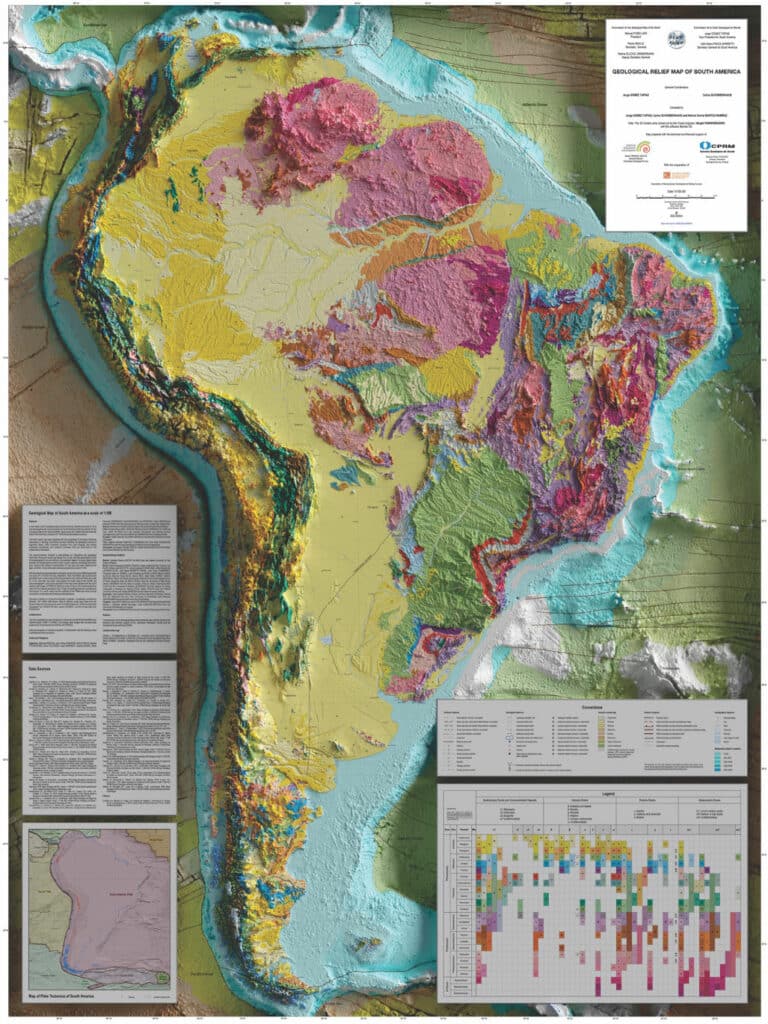
Conclusions
The GMSA summarizes 3.4 Ga of the South American subcontinent’s geological history based on the geological cartography produced and updated by geological surveys and the results of numerous studies published in the last 20 years since the publication of the GMSA’s previous edition (Schobbenhaus and Bellizia, 2001).
To complete the GMSA, a proprietary methodology was used, applying the latest advances in GIS. Within this methodology, the effective georeferencing of the information stands out, as this will allow updates to the map in less time than previously. The authors hope that the methodology implemented for the GMSA’s production will be useful for other researchers with the titanic task of constructing small‒scale geological maps and that the map will serve as support for new research across South America and the entire planet, not only in geology but also in other fields.
The GMSA has been published in several formats that are available to users. Table 1 includes the URL where the GMSA can be downloaded in different formats, completely free of charge, from the CGS’ website.
Acknowledgments
The authors wish to express their sincere gratitude to Dr. Oscar Paredes Zapata, General Director of the Colombian Geological Survey from 2011 to 2022, and to Dr. Esteves Pedro Colnago, Director‒President of the Geological Survey of Brazil, for his unconditional support in the development of the GMSA.
We also appreciate the contributions of the 58 collaborators from the geological surveys of South America, universities, and research centers. The GMSA project was funded by the Colombian Geological Survey and the Geological Survey of Brazil.
